Fall Protection systems are used to avoid mishaps and control the risks associated with working near openings or at heights. These are used in overhead platforms, elevated workstations, etc. The fall protection system is used across industries that include Construction Industry, Aeronautical Industry, Chemical engineering, Wind Energy, Oil and gas plants, Heavy manufacturing units to name a few.
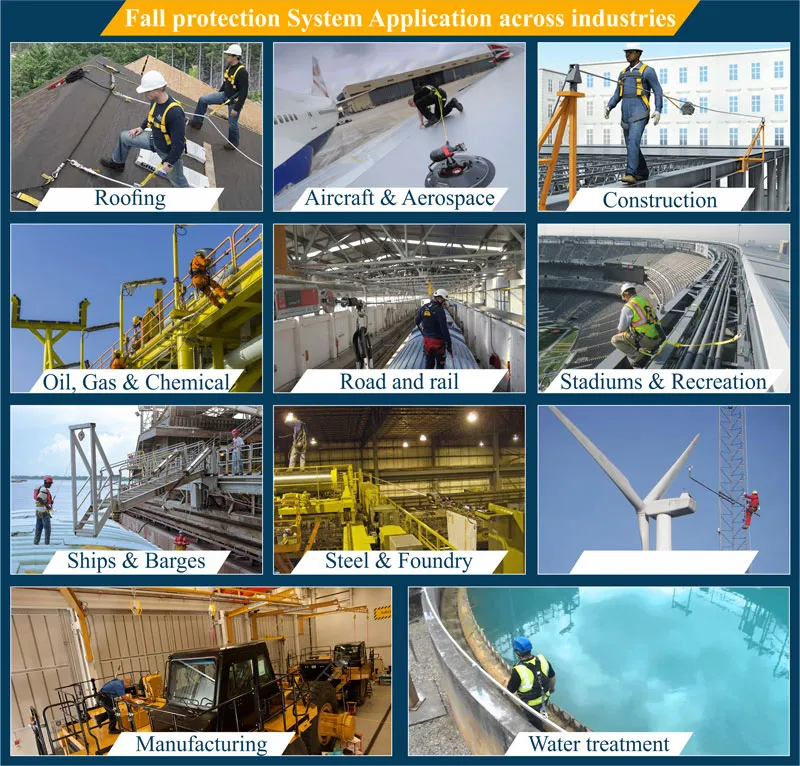
Where Is Fall Protection System Required?
- Unprotected sides or edges in high rise buildings and superstructures
- Leading-edge pre-post construction work of commercial buildings
- Maintenance services on aircraft, on the top of airplanes, fuselages and wings
- Climbing the derrick ladder work in the oil and gas industry
- Steel and foundry work moving and pouring molten material
- On ramps, runways or other walkways in commercial building
- For window washing and painting in high rise/ commercial/ residential building
- Utilities and energy sector maintenance works
- Overhand bricklaying and related work
- Roofing activities across industries
- Erecting precast concrete members
- Maintenance, repair, and cleaning of railroad cars
- Near wall openings in commercial buildings
- Operating machinery in a warehouse or production
- Installing and maintaining solar panels and equipment on roofs and elevated surfaces
- Waste and water plant rooftops and elevated work areas etc.
Different fall protection systems used across industries
Based on the principle of fall arrest, resistance and prevention there are different types of fall protection systems used across industries.
Roof fall protection system
The rooftop work environment requires special safety measures for the workers. The selection of the right roof fall protection system products can mitigate the risk of mishaps and ensure safety. There are different types of products used for roof fall protection as given below.
Single point anchor – provides a cone of coverage area. It can be used to anchor to steel, concrete, shock-absorbing posts, and rope access Sydney systems, allowing workers the freedom of movement.
Rooftop guardrail – modular, free-standing roof edge safety railing that does not penetrate the roof membrane. It can be quickly and easily assembled and installed onto most rooftops. It utilizes a counter-weighted system that can be installed with minimal effort.
Parapet Roof Railing – directly screwed to the rooftop parapet. Depending on the height of the parapet, uprights may have one or two rails. Specialized fittings allow the railing to turn at any angle that is needed to secure the perimeter of the rooftop.
Rooftop Walkways & Crossovers – used for ease of access between varying roof elevations, over tripping hazards, over openings and parapets. For slippery or unstable working surfaces they provide safe means of access, egress, and walking surfaces. It can be designed and fabricated for all styles or roofs, including membrane and standing seam metal.
Skylight screens – cover the skylight with a wire mesh to protect workers from accidental falls and lacerations. It is available in a variety of sizes, shapes, and materials to fit almost any roof opening and smoke vent.
Warning line – barrier erected on a roof to warn workers that they are approaching an unprotected roof side or edge
Roof Hatch – offers perimeter protection to prevent falls and provides a place for the worker exiting and entering the hatch to grab onto.
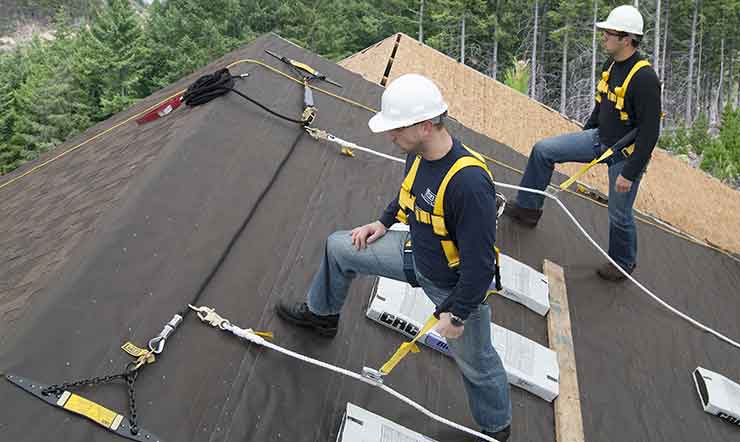
Anchor point system
Anchor points can be installed on the roof, doors and windows. These are used to connect lanyards, lifelines, and other forms of tie-off which prevent a worker from mishap.. Roof anchors can be as simple as a D-ring connection or a complete lifeline system. There are different types of anchor point products used across industries.
Rigid Post-Single Point Anchors – utilized for fall arrest and tie-back applications including suspended platforms, window washing operations, equipment tie-back, and rooftop fall protection.
Tip-Over Post Single Point Anchors – designed for rooftop applications with pitches of 4:12 and less. can be utilized with a wide variety of roofing substrates including single-ply membrane, built-up asphalt, metal, and standing seam metal roofs.
Portable Single Point Anchors – used for temporary construction, steel erection, and rooftop maintenance applications. It provides free-standing tie-off points, eliminating the need to attach to the roof surface.
Vacuum Single Point Anchors – ideal for aircraft maintenance and inspection applications, providing temporary It can be used for single-point fall protection, or paired to create a temporary Horizontal Lifeline.
Fixed Truss Anchor Kits – fast-installing fall arrest product that uses the structural truss design of your building to create a tie-off point for workers. It is used by mechanically attaching steel plates and a threaded bolt and nut combination.
D-Ring Single Point Anchors – secure anchor point installed onto any surface that can connect a lanyard, self-retracting lifeline, or other connectors for a complete protection system. It is ideal for concrete walls and parapet works.
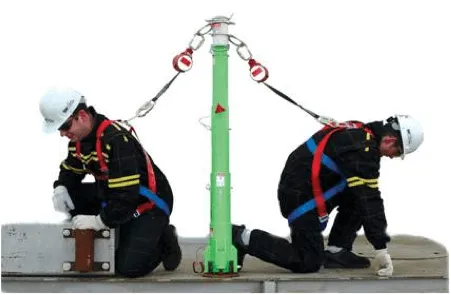
Cable based lifelines
Cable-based lifeline systems provide a safe means of tie-off for workers in a variety of applications. Whether designed for an overhead application, such as an aircraft hangar, or at foot level on a roof, it ensures the safety of workers. Different types of products include;
Horizontal lifelines – common fall protection products in work areas that lack existing anchor points for personnel tie–off. The horizontal lifeline consists of a cable attached with two or more anchor points. They ensure mobility, versatility and productivity and can be used along crane rail runways, pipe racks, bridges and many other applications.
Vertical Lifeline – allows up and down movement of workers by eliminating the need to find new tie-off points while ascending or descending from a tower or ladder. By connecting to the vertical lifeline using a shuttle or traveler, workers may move as long as tension is slack on the lifeline. In the event of a fall, the shuttle automatically engages the vertical lifeline and locks it, avoiding mishaps.
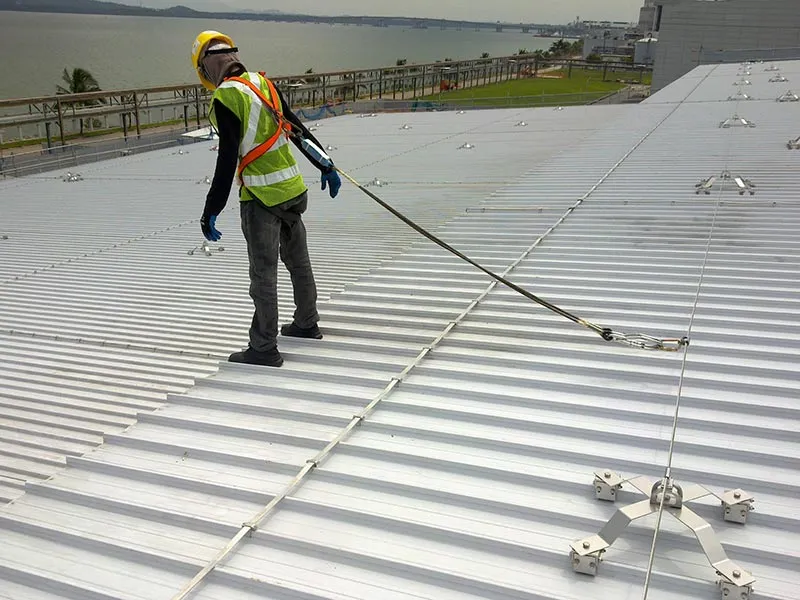
Ladder fall protection system
Falls from ladders are a leading cause of fatal injuries across industries. Ladder fall protection with a shuttle connects to a worker’s harness D-ring. The shuttle serves as a mobile anchor point that travels with the worker as they make their way up and down the ladder. In the event of a slip, the traveler engages the cable and arrests the worker’s fall. Here are different types of products used for ladder fall protection.
Roof Access Ladders – designed with Set and Bolt Technology for precise placement and adjustment of stand-off brackets.
Ladder safety gate – acts as a safe barrier to fixed ladders and access points, mitigating the risk of mishap. They are easy to install and feature an adjustable tension spring protected within a galvanized cylinder.
Edge protection guardrail – a barrier to the roof’s edge. Its counterbalanced design provides free-standing and durable edge protection without penetration of the roofing membrane or the building or structure.
Fixed Ladder – attached to a structure, building, or equipment. It is used as a convenient tie-off point to existing ladders and can be placed in any position behind the ladder rung.
Ladder Rigid Track – connects the worker to the system via a rail shuttle and automatically follows the user for hands-free climbing, and locks onto the rail in the event of a mishap., allowing the user to regain their footing.
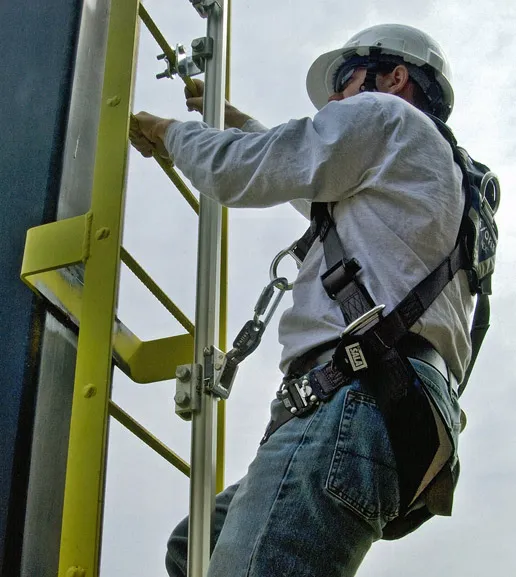
Scaffold fall protection system
Fall protection is an extremely important aspect of scaffolding safety and proper fall protection procedures must be implemented on all construction sites. There are several products available to ensure safety for scaffolding fall arrest and fall protection systems.
Full Body Harnesses – designed to hold the wearer upright in the event of a fall from height. It distributes the energy generated during free-fall across the wearers’ body evenly, reducing the potential for serious mishaps.
Shock-absorbing lanyards – these are used in conjunction with safety harnesses. It has an oven shock-absorbing inner core that smoothly expands up to 42 inches or more to reduce fall arrest forces.

D-Ring Connector and Aluminum Locking Rebar Hooks – reduces fall clearance requirements which makes it useful in more applications. It optimizes freedom of movement and prevents the webbing from twisting or binding to the working unit.
Tieback Anchors – used for a wide range of suspended access applications, including window cleaning and exterior building maintenance. The product provides an ideal safety solution for rope descent systems where specific use and height restrictions apply and workers are operating suspended power platforms and temporary rigging equipment.
Perimeter nets – these are retractable netting systems that mount directly to the building or structure beneath where the crews are working. Support poles stick out from the building at an angle and hold a man-rated safety net to catch someone in case of a mishap.
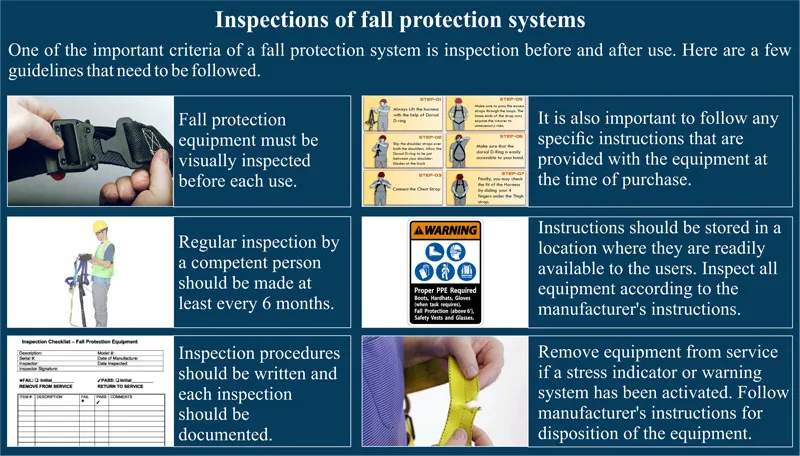
Conclusion
Choosing a fall protection system depends on your environment and the requirement of the work being undertaken. It is the responsibility of the employer to ensure the appropriate measures are in place to prevent mishaps of the workers. Being aware of safety precautions and selection of the right equipment is therefore pivotal. Make sure the fall protection system is suitable for your work environment while staying compliant with the Working at Height regulations. More article series on fall protection systems will follow.



